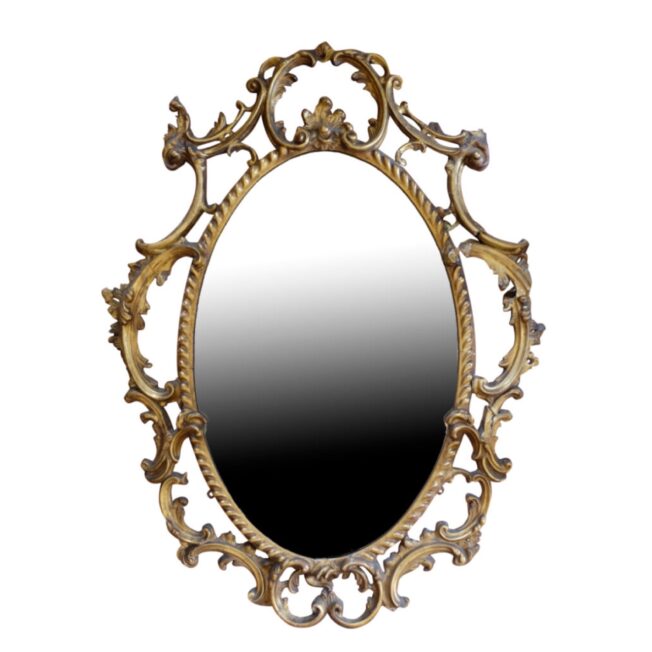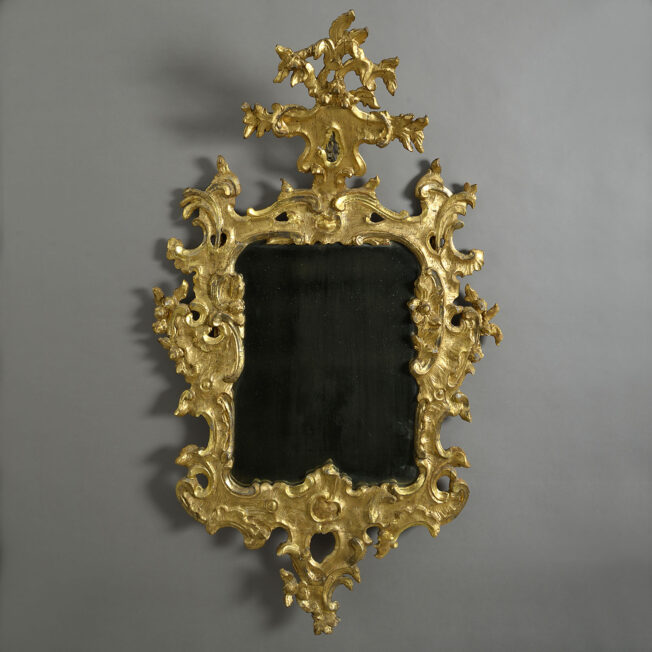Fine Louis XVI Carved Giltwood Trumeau Overmantel Mirror
£8,500
An exceptionally fine Louis XVI carved giltwood trumeau/overmantel mirror, the original, rectangular plate with carved laurel branches below and surmounted by a frieze of scrolling rinceaux incorporating cornflowers (Marie-Antoinette’s favourite blooms) and centred by a Bacchic mask, in turn surmounted by a painted panel on canvas in the manner of Charles-Louis Clérisseau with a central cartouche of a dancing nymph flanked by winged female terms holding bunches of grapes and ending in scrolling grapevines, the whole in a moulded frame with bead and ribbon-twist borders
Probably intended to hang in a room decorated with painted panels in grotesque or arabesque style rather like the chamber executed for Madamoiselle Sophie at Versailles, design here illustrated.
Stron similarities can be drawn with a group of five painted boiserie panels (illustrated) sold Christies New York.
‘DALVA BROTHERS: PARISIAN TASTE IN NEW YORK’, 22 Oct 2020, lot 198
Charles-Louis Clérisseau, 1721-1820, was a French architect, draughtsman, antiquary and artist who became a leading authority on ancient Roman architecture and decoration. Born in Paris, in 1746 he won a scholarship to study at the prestigious French Academy in Rome. On his eventual return to Paris, he worked with Etienne de Vallée on the Hôtel Grimod de la Reynière, built in 1775, devising the first decorative scheme in Europe based on recent discoveries in Herculaneum and Pompeii – eight painted boiserie panels from this scheme are in the Victoria & Albert Museum. Clérisseau went on to work for other illustrious patrons, including Catherine the Great and Thomas Jefferson. Catherine the Great purchased a huge cache of Clerisseau’s drawings for ornament and these, two here illustrated, remain at the Hermitage Museum. Clerisseau also influenced other contemporary architect/designers notably François-Joseph Belanger (1744-1818), Jean-Démosthène Dugourc (1749-1825), and Henri Salembier (1757-1820) each of whom embraced this new style which was quickly incorporated into court taste and became known as gout Arabesque or gout Etrusque, Dugourc publishing a series of engravings promoting this new decoration (one here illustrated). Interiors in this style were created for Louis-Marie-Augustin, duc d’Aumont at what is now the Hôtel Crillon, the interior itself is in the Metropolitan Museum of Art, New York. The Comte d’Artois also embraced this new style in his apartments at Versailles and the Temple, and in his charming Folie of Bagatelle. Marie-Antoinette had a cabinet created at Fontainebleau and, as we saw from the design. Madamoiselle Sophie had an utterly charming apartment at Versailles in the same style.
Judging by the style of the giltwood frame of the offered mirror, it must come quite early in this canon of work, probably some time between 1775 and 1780 and, with the high quality of carving and the court-favoured arabesque decoration, it is tempting to posit a royal provenance. If it is a royal piece, and as it was more than likely fitted within boiserie it therefore bears no inventory marks or numbers, the most likely candidate is the Comte d’Artois, who espoused this new style with gusto, and had a suite of rooms in the Palais du Temple decorated in this manner, as well as his bibliothèque dorée at Versailles.






















